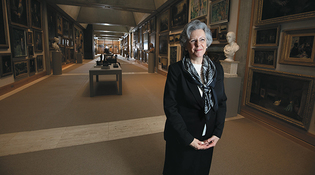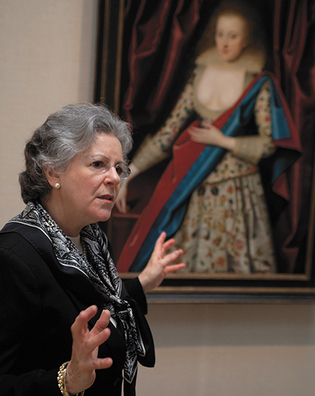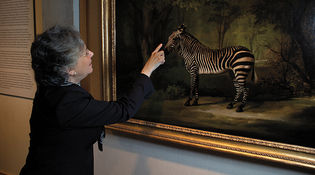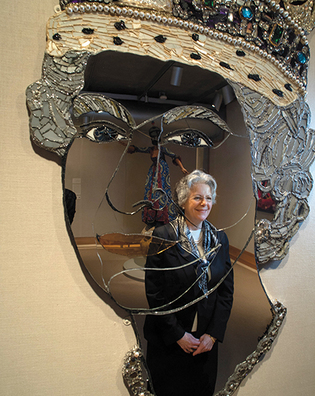 loading
loading
featuresExit interviewThe departing director of the Yale Center for British Art looks back, and forward.  Mark OstowAmy Meyers, director of the YCBA, in the building’s Long Gallery. In daytime, the gallery is filled with natural light from the skylights in the ceiling. View full image Mark OstowView full imageIt’s a story we told years ago. But it’s well worth a second round. In April 1977, Amy Meyers ’85PhD and her fiancé, Charles “Jack” Meyers III ’72, drove to New Haven. She was torn between enrolling in graduate school at Yale or at the University of Chicago, where she’d gone to college. But her father, a professor at Notre Dame, believed in the benefits of an intellectual change of scene. He’d commissioned Jack to show her the place. They had barely arrived when they bumped into Jack’s friend Paul Goldberger ’72, an architecture critic. Jack asked what he was doing in New Haven, and Goldberger said he was on assignment for the New York Times, reviewing a major new building that was opening that night. In the morning, the couple visited that building: the Yale Center for British Art. “We walked in the front door,” Amy Meyers recalls, “and it was this gorgeous court filled with tulips—this beautiful, light-filled, welcoming space.” They went up to see the collections, and she still remembers the course they took and the placement of many of the signature paintings. “And as we were walking out, I can remember saying, ‘Jack, OK. This is it. This is just too extraordinary. Of course I’m going to come here.” When the Yale Alumni Magazine recounted a shorter version of that moment, Meyers had only recently become the YCBA’s director. This June 30, she retires from the job after 17 very active years. (Courtney J. Martin ’90PhD, deputy director and chief curator of Dia Art Foundation, will be her successor.) In Meyers’s time as director, she has overseen—among other things—extensive conservation work on the building, which is a Louis Kahn masterpiece; publication of a conservation plan for the building’s maintenance, from the auditorium to the plumbing to the elevator buttons; a rethinking and reinstallation of all the works on display; and the opening of the stately Long Gallery (previously divided by temporary walls) in the form Kahn had envisioned. Meyers emphatically credits colleagues Scott Wilcox and Matthew Hargraves for the Long Gallery art display, and Constance Clement for the conservation work. In addition, Meyers oversaw an abundance of research collaborations. It’s the Yale “Center” for British Art, not “Museum,” she specifies, because Yale and its founder, Paul Mellon ’29, wanted it to be a major research institute as well as a teaching museum. Paul Mellon gave the YCBA an endowment, its building, and his enormous collections of British art, rare books, and manuscripts. Modestly, he required that the center not bear his name. But he took great satisfaction in founding a place for research. Meyers, an academic herself with exacting standards, has raised the YCBA’s research bar. If you visit New Haven before May 21, you can stroll through an exhibit on the history of The Hunterian, one of the world’s first public museums. It was founded in Glasgow with the private collections—art, coins, natural history, and more—of William Hunter (1718–1783), an anatomist whose research made childbirth much safer. (His magnum opus was The Anatomy of the Human Gravid Uterus, a huge volume of drawings of dissected uteri. It’s hard to take, but it helped save innumerable lives.) In collaboration with scholars at The Hunterian, the YCBA has published a 440-page book of scholarly articles about his collections. In Meyers’s time, the YCBA has organized nearly 50 such international loan exhibitions, each involving dozens of US and international scholars—as well as Yale grad students and undergrads. And the YCBA’s director also serves as CEO of the Paul Mellon Centre for Studies of British Art, in London, a YCBA affiliate that underwrites scholarship in the field. One of Meyers’s most significant contributions to the YCBA has been a rethinking of the works on permanent display. While the building was closed for conservation work, she held a series of workshops to reevaluate. Mellon’s vast collection includes works from many places Britain colonized, but few of them could be seen on the walls. Before the reinstallation, a stroll through the YCBA always included a surfeit of British aristocrats. Now, there are also works that were painted in India, China, the Caribbean, and North America, including works by artists native to those places who had come under subjugation by the British. Moreover, the labels have changed. Formerly, paintings including both white Europeans and enslaved people of African descent would have been labeled only with the names of the Europeans. There was no mention that other people were present. Today the labels acknowledge everyone pictured—though some names will probably never be known. The YCBA also regularly commissions new artwork, and some of those pieces comment powerfully on the nature of empire (see page 46).
 Mark OstowView full image Mark OstowView full imageAs Meyers approaches the end of her tenure at YCBA, she appears to have no regrets about leaving. She was enthusiastic and excited about taking a small group of Yale Alumni Magazine writers and photographers around in late March to see some current exhibits. Asked why she decided to leave, she says, “There are many personal research projects that I look forward to pursuing, and uncharted paths to explore. After 17 years at the center’s helm, it’s time to hand over the leadership to a visionary new director.” She’s looking forward to her next piece of art-historical scholarship: a traveling exhibit about the Bartrams, a Philadelphia family that founded the first scientific garden in North America, in the 1730s. (She’ll cocurate it with Therese O’Malley of the National Gallery of Art.) Meyers—who is constantly aware that there may be complications and cruelties, as well as triumphs, lying behind a work—will also focus the exhibition on the family’s relationships with Native American peoples and with the enslaved Africans who toiled on the Bartrams’ plantations in Carolina and Florida. It just happens to be a project, as she says, “very much about Britain and its developing empire.” How will she manage, in the future, to stay away from the YCBA—the largest art collection in the United States concerning Britain and its developing empire? Meyers emphasizes that she wants to give the new director space. But of course she’ll visit. “I’ll come on Sundays,” she jokes. “Quietly.”
The comment period has expired.
|
|